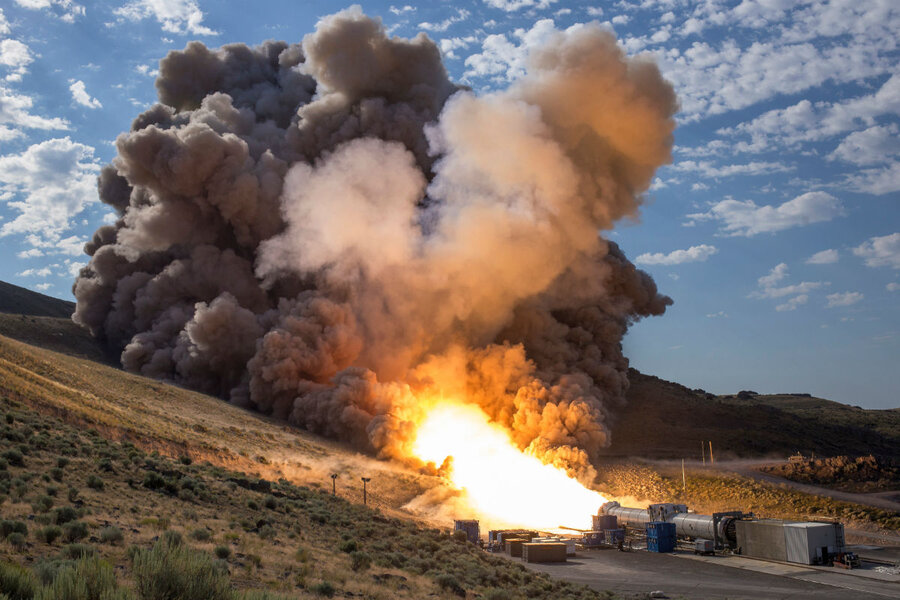Apollo 8 redux: Why NASA may send humans around the moon, again
Loading...
In 1962, John F. Kennedy challenged NASA to visit the moon. Now 55 years later, President Trump is asking NASA to return. Or at least to accelerate plans for a crewed capsule to orbit our celestial neighbor.
The current timeline calls for NASA’s next generation rocket, the Space Launch System (SLS), to send an unmanned capsule for a loop around the moon by 2019. But at the request of the White House, the space agency will conduct a one-month study looking into what it would take to put some people on board.
Initiated in 2011 to take the place of the over-budget and behind-schedule Constellation program as a shuttle replacement, the new super rocket SLS is currently scheduled to fly its maiden Exploration Mission 1 (EM-1) in late 2018 or early 2019, launching an Orion space capsule on a trajectory that would take it around the moon and back to Earth. A crewed mission would follow with EM-2 between 2021 and 2023, after undergoing some essential upgrades, such as life support systems.
But the new administration wants NASA to return to space with a manned lunar exploration program. Now, the space agency is responding with a feasibility study investigating what resources would be required to make such a move happen sooner rather than later.
The idea is to combine EM-1 and EM-2 into one mission, developing and adding the systems necessary to keep the cabin pressurized with breathable air. If successful (and affordable), NASA would be able to launch a crew of two on EM-1 into high Earth orbit, after which they would continue on to orbit the moon before returning home, spending a total of eight or nine days in space.
In other words, the mission would be almost identical to Apollo 8, but with a bigger and badder rocket.
But such a change may be easier said than done. Moving up the timeline will require additional resources to develop and test multiple new systems at once, from life support to emergency escape capabilities. And that testing won’t be cheap.
"From our previous assessment, we know it’s going to take a significant amount of money – money that would be required fairly quickly," NASA's lead manager for the SLS rocket and Orion spacecraft, Bill Hill said during a teleconference on Friday.
And money alone won’t get the job done. The new EM 1 - 2 hybrid mission would likely fall somewhere between the two dates originally proposed.
"This study will determine how much additional time is needed … to add crew to EM-1," Bill Gerstenmaier, NASA's associate administrator for human exploration and operations, told reporters during the same teleconference. "We will definitely have a [later launch date]. We also recognize we'll need to add some additional funding."
Beyond the time and money, some worry about the additional risk as well. "We are not proposing what the outcome of NASA's assessment should be," said Patricia Sanders, chairwoman of the Aerospace Safety Advisory Panel (ASAP). "But in the assessment, we strongly advise that NASA carefully and cautiously weigh the value proposition for flying crew on EM-1."
While the new mission wouldn’t be filled with groundbreaking scientific firsts like its predecessor was nearly 50 years ago, it could offer advantages to NASA. According to Mr. Hill, getting the life support systems ready in time for EM-1 would free the next mission for something more ambitious, Ars Technica reports.
With launches coming in at a price $1 billion per mission, SLS is expected to launch at most once every one to two years, focusing on deep space targets like Mars and Europa and leaving Low Earth Orbit operations such as the International Space Station to the workhorse rockets of SpaceX and Orbital Alliance. Getting the test flights out of the way early could let the real work begin quicker than expected.
Quartz writer Tim Fernholz raises another question: Is this the best use of taxpayers dollars, given the rise of private space companies?
Developing the the two vehicles costs $3 billion a year, and the rosiest projections suggest annual costs of $2 billion, assuming one launch each year. With commercial rocket firms including United Launch Alliance, SpaceX and Blue Origin promising to put nearly-as-powerful but significantly cheaper products on the market in the years ahead, many wonder if NASA should be putting so much of its resources into projects they may be quickly outmoded.
Until the agency releases its report, no one will know what concrete costs or hard benefits might result from trying to please the White House, but NASA indicates that it’s happy to at least consider the proposition.
“We recognize this will be an increased risk," said Mr. Gerstenmaier "We take that increased risk, and we take it against the benefits we gain by doing this, and we say, ‘Is that something that is worthwhile for us to go and do?' Then we have an agency-wide discussion on whether this is an appropriate risk for us to take.”








